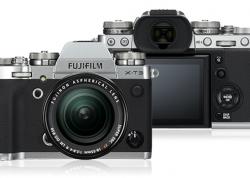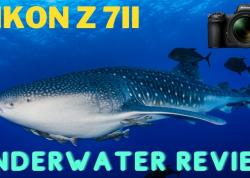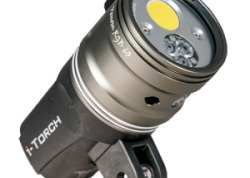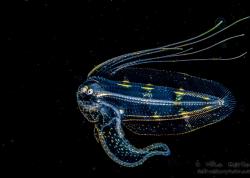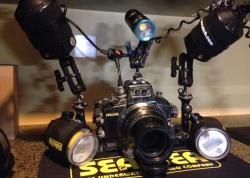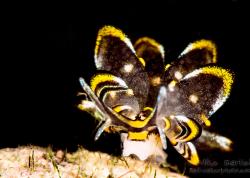Nikon D500 Review with Sea & Sea MDX-D500 Housing
At last, Nikon has finally released the successor to its series of pro-consumer sensor cameras, the D500. A clean jump over the cloud of mid-consumer grade bodies that were released in the interim, the D500 is a solid and robust camera that will surely function at a higher professional level for many years.
I have to admit, I was waiting for the D400 to materialize, but when it never came I felt I had to settle with the D7100. I used that system each day and logged more than 1200 dives on my Sea & Sea MDX-D7100 housing without any rebuilds, which is a true testament to durability and reliability. Looking back on that system, overall I was very pleased with that decision and will continue to use that setup as a backup.
It’s also important to disclose that I am not being paid by Nikon, Sea & Sea or Bluewater Photo for this review, and while I'm not a technical writer, I’ll be honest and as thorough as possible.
I dive 20+ days a month logging 500-600 dives a year, and I rarely enter the water without my rig. I’m not easy on my gear but do daily rinses and regular O-ring maintenance.
This quick review of the Nikon D500 will be in comparison to the D300s and D7100 camera bodies - both APSC sensors. My choice for shooting on an APSC sensor comes from the style I shoot the most, which is macro. And while I enjoy shooting wide, my biggest use for the D500 will be the small stuff. I also shoot fully manual strobes using sync cords and rely on autofocus for most shots.
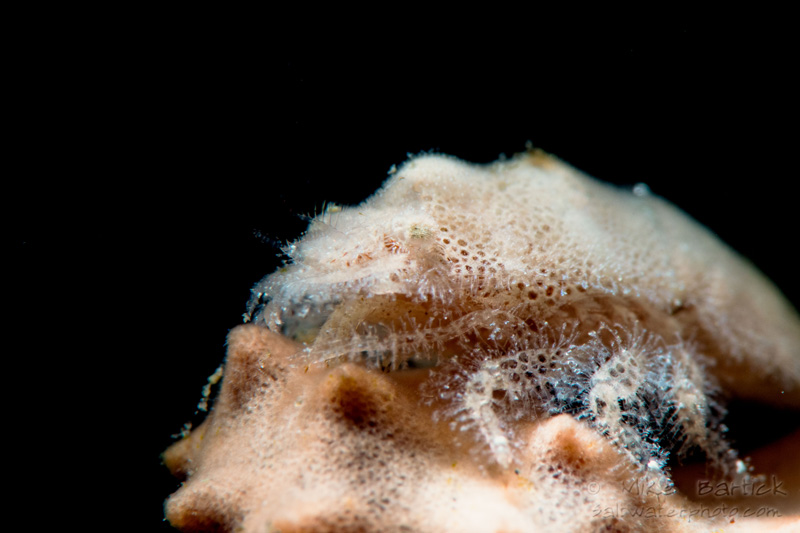
Supermacro view of a Cryptic sponge shrimp
Nikon D500 with Nikkor 105mm macro lens, INON CL67 diopter, Retra Snoot, Sea & Sea YS-D2 strobe
The subtle details of the shrimp were picked up well in this image. I used the AF lock lever to secure the critical focus point and standard shutter release to capture the image. Selecting the proper focal point is faster and more precise using the “4-key” command dial on the MDX-D500 housing verses the single round selector found on the 7100 housing.
Nikon D500 Feel and Form:
Out of the box the D500 body feels solid in the hand, ergonomic, and like the others in the series (D200, 300, 300s), it’s easy to function with small or larger hands. It’s weather sealed and will withstand water droplets, mist and other natural environmental challenges.
The D500 comes with a reduced amount of megapixels (20.9 million) packed into its 24x16 DX CMOS sensor without the low pass filter, offering a very suitable dynamic range. The video function shoots at 4K resolution, plus alternative choices, and provides memory slots for fast XQD and SD memory cards.
I purchased the camera while in the US and tested the body right away shooting butterflies and other terrestrial subjects while waiting for the housing to be manufactured, and I had a hard time setting the camera down. The camera really is fun to shoot. When shooting at 10 frames per second, the shutter sounds like a machine gun and is sure to turn some heads when shooting shoulder to shoulder with other photographers! While this capability might not be used everyday underwater it will certainly make any sports photographer happy, and with its expandable ISO ranges, capturing action from a distance or in low light conditions should never be an issue.
The most significant drawback for the D500 camera body is the lack of pop up flash. For me it’s a non-issue, but it does force the underwater shooter to purchase a flash trigger to use fiber optic cables (instead of sync cords), which means an added expense if he/she chooses to shoot with that method.
I have seen the largest improvement in the D500 over the D7100 and D300/300s in the image quality. The images seem sharper and cleaner - even in the RAW files, which is particularly evident when I shoot fluoro images at high ISO (1600) and in a darker environment. The D7000/7100 series failed miserably here, so I was quite pleased to see the difference. I’m also excited to say that I have not seen any sensor diffraction from shooting at accelerated F-stops of 22 or greater. This is really good news if you like to shoot super macro or need to stop down to the extreme.
You can find many more technical specs to in UWPG’s Nikon D500 First Look article.
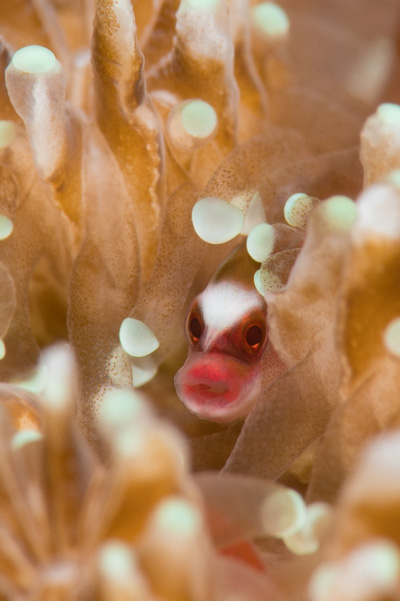
Rare hard coral pipefish
Nikon D500 with Nikkor 105mm macro lens (*cropped), dual INON Z-240 strobes
Clean, sharp and good on noise. The D500 eats macro subjects for lunch and the housing is small enough to squeeze into tight spots. This small coral head took a bit of yoga maneuvering to gain access. The sensor doesnt seem to have the diffraction issues of the D7100.
The Sea & Sea D500 Housing Feel and Function:
Finally, after much anticipation and patience, I've been able to pair my D500 with the new Sea and Sea MDX-D500 housing and get it in the water. The MDX-D500 housing is a small, simple and rugged housing system.
Stark improvements and subtle details can be seen inside of the housing and out, starting with the main selector dial. The MDX-D500 has shifted back to the 4-key main dial that controls the camera’s main wheel from the outside. The subcommand dial is located on the right. Thumb access allows for very quick AF point selections to be made, which helps you create stronger compositions while shooting.
A slightly larger rear window provides greater visibility of the LCD screen – useful for reviewing images, checking your histogram and shooting video. The OK button remains in the same place, which might confuse the D7000 line of shooters (that button is located in a different position). The ISO control is a lever at the index finger tip just behind the shutter release and with just a few dives becomes highly functional in its new location.
The Sea and Sea camera mount ensures a consistent and solid fit each time you slide your camera body into the housing. The mount also allows 3D tracking to be enabled using the lever located on the left of the housing just above the AF/MF lever.
The levers on the right side of the housing - AF lock, ISO, Video - seem a little cramped, but with the smaller housing size it’s a fair trade-off. Using the levers is a simple task when making adjustments or toggling to video and back. The review lever, located on the left thumb, provides quick reviews when pushed up and zooming into the reviews image when pushed down. I use this new function frequently and love it.
The MDX-D500 housing has changed the back to a dual latch locking system, securing the housing together. Water channels near the housing O-rings and grooves direct droplets of unseen water away from the open back. This is handy when changing lenses on the boat from the front of the housing or the rear. Bulkheads are in place for electronic modular strobe connectors, auxiliary video screen or vacuum systems.
Underwater, the housing might feel a bit heavier in the hand since the smaller housing doesn’t hold the same volume of air as some of the bulkier housings on the market. I recommend using float arms to counter balance the system to your liking. One key benefit to the small housing size is that the buttons are easy to access for small hands.

Feeding Lizard fish
Nikon D500 with Nikkor 105mm macro lens, Kraken 1000 lumen light
Testing the sensitivity of the white balance wasn't the idea when I shot the image. My strobe cable had failed and i quickly switched to using my 1000 lumen torch. It worked well enough to pull out a decent shot. I'll use this technique a little more down the road to see how far I can run with it.
Shooting Underwater
Macro: 60mm, 105mm, 105mm + diopters
Macro is always going to be the easiest shooting style for controlling color balance, and as expected the D500 is a monster for macro. Quick AF point selections and compositions are fast, focus is quick, and access to the back-button focus mechanism, seamless. This is vital to gain critical focus on super macro subjects and for rapid firing. The D500 continues to be a bit fussy to fire at times but I've overcome that using the focus locking function. The 3D focus tracking is also a great tool for tracking subjects within the frame. Once the focus point has been selected, recomposing within the frame is a snap.
Shooting Underwater
Wide-Angle: Tokina 10-17mm fisheye with Zen dome port
I like to shoot with the sun either entirely in the frame or completely out of the frame, rarely overlapping the edge of the frame. This seems to be the best way to get the full force of the sun onto the camera sensor, control it, and create a “bright and tight” orb in the frame. The D500 handled the sun without any issues and with very little effort. I shot fast and slow shutter speeds and could see the difference on the smoothness of the surface while retaining the same light qualities from the shadows to the sun.
I also shot in the shallows to capture sunrays. This was easier than I had anticipated and I was able to do so very easily with higher shutter speeds. Without any large creatures or any significant reef fish for this test, I selected a couple of well-formed coral heads that cooperated by not swimming off.
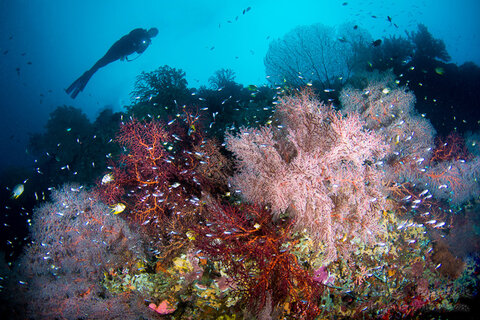
Dynamic Range Test, Dark to Light
Nikon D500 with Tokina 10-17mm fisheye lens, Zen mini dome, dual Sea & Sea YS-D2 strobes
Changing the port and lens from the front of the housing is a fast and easy task with the MDX-D500 housing. Accessing the shutter speed dial and f-stop dial is simple on the housing, although the levers do feel a bit cramped. ISO is easy to adjust on the fly, which I use when shooting W/A quite often depending on my depth.
Nikon D500 Noise Test:
Blackwater diving is part of my routine and ISO speed is usually set to 650. This is very helpful when cropping very small subjects during post processing. I’ve even used the cropped DX function in the D500 and it seems to add a slight magnification to the macro images, allowing me to fill the frame a bit more.
I did see some noise in my fluoro images shot at ISO 1600 and expanded to 100%. But this is probably an extreme example of searching for digital noise rather then noticing it take away from image quality. For everyday use and publication on the Internet, the noise at these ISOs will never be an issue.
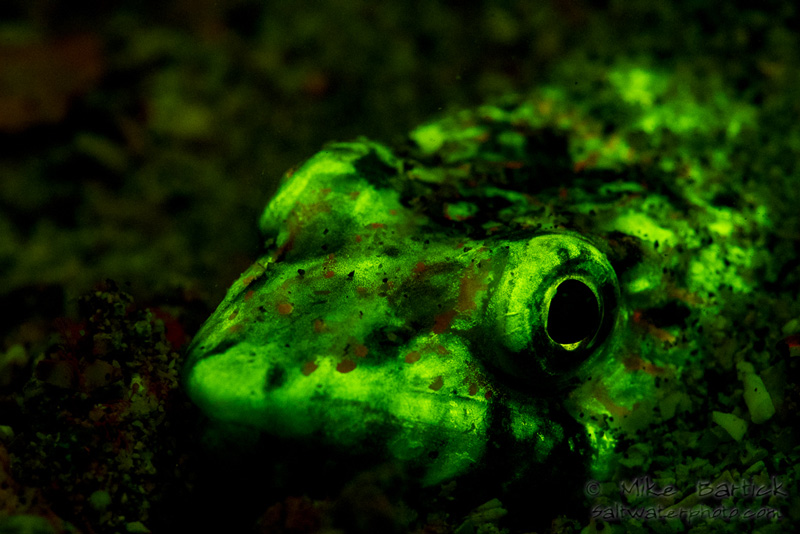
Fluoro Lizardfish
Nikon D500 with Nikkor 60mm macro lens, Kraken 2800 torch on blue, 1 Sea & Sea YS-D2 strobe with blue diffuser
When we check for noise at ISO 1600 it's apparent, although the image is still of high-enough quality for print publication and digital dissemination.
Learn more about underwater fluoro photography.
In Conclusion
Overall, I am happy with the D500’s performance after 20 days of diving. It’s a powerhouse of a camera that will perform well for underwater shooters and topside shooters alike.
The Sea and Sea MDX-D500 housing is the ultimate fit for the D500 and I highly recommend it.
Ease of use, durability, function, button access and price point make the Sea and Sea housing a definite buy. The wait is over, get out there and buy one - you’re going to love it!
RECOMMENDED ARTICLES
SUPPORT THE UNDERWATER PHOTOGRAPHY GUIDE:
The Best Service & Prices on u/w Photo Gear
 Visit Bluewater Photo & Video for all your underwater photography and video gear. Click, or call the team at (310) 633-5052 for expert advice!
Visit Bluewater Photo & Video for all your underwater photography and video gear. Click, or call the team at (310) 633-5052 for expert advice!
The Best Pricing, Service & Expert Advice to Book your Dive Trips
 Bluewater Travel is your full-service scuba travel agency. Let our expert advisers plan and book your next dive vacation. Run by divers, for divers.
Bluewater Travel is your full-service scuba travel agency. Let our expert advisers plan and book your next dive vacation. Run by divers, for divers.




